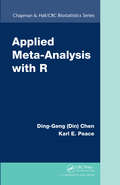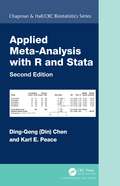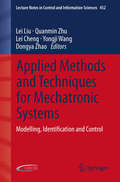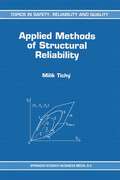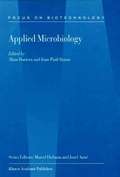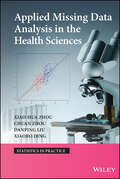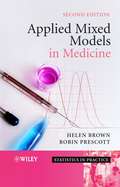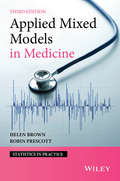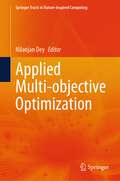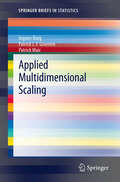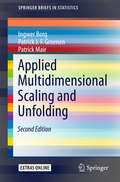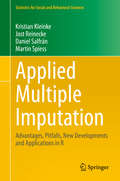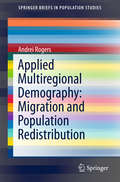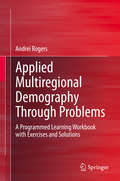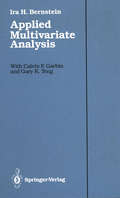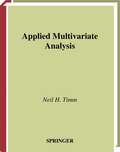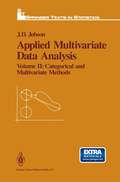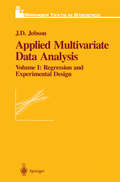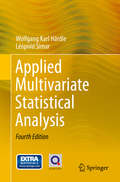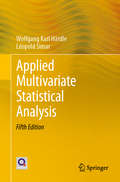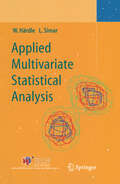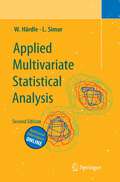- Table View
- List View
Applied Meta-Analysis with R: Applied Meta-analysis With R
by Ding-Geng (Din) Chen Karl E. PeaceIn biostatistical research and courses, practitioners and students often lack a thorough understanding of how to apply statistical methods to synthesize biomedical and clinical trial data. Filling this knowledge gap, Applied Meta-Analysis with R shows how to implement statistical meta-analysis methods to real data using R. Drawing on their extensiv
Applied Meta-Analysis with R and Stata (Chapman & Hall/CRC Biostatistics Series)
by Ding-Geng (Din) Chen Karl E. PeaceReview of the First Edition: The authors strive to reduce theory to a minimum, which makes it a self-learning text that is comprehensible for biologists, physicians, etc. who lack an advanced mathematics background. Unlike in many other textbooks, R is not introduced with meaningless toy examples; instead the reader is taken by the hand and shown around some analyses, graphics, and simulations directly relating to meta-analysis… A useful hands-on guide for practitioners who want to familiarize themselves with the fundamentals of meta-analysis and get started without having to plough through theorems and proofs. —Journal of Applied Statistics Statistical Meta-Analysis with R and Stata, Second Edition provides a thorough presentation of statistical meta-analyses (MA) with step-by-step implementations using R/Stata. The authors develop analysis step by step using appropriate R/Stata functions, which enables readers to gain an understanding of meta-analysis methods and R/Stata implementation so that they can use these two popular software packages to analyze their own meta-data. Each chapter gives examples of real studies compiled from the literature. After presenting the data and necessary background for understanding the applications, various methods for analyzing meta-data are introduced. The authors then develop analysis code using the appropriate R/Stata packages and functions. What’s New in the Second Edition: Adds Stata programs along with the R programs for meta-analysis Updates all the statistical meta-analyses with R/Stata programs Covers fixed-effects and random-effects MA, meta-regression, MA with rare-event, and MA-IPD vs MA-SS Adds five new chapters on multivariate MA, publication bias, missing data in MA, MA in evaluating diagnostic accuracy, and network MA Suitable as a graduate-level text for a meta-data analysis course, the book is also a valuable reference for practitioners and biostatisticians (even those with little or no experience in using R or Stata) in public health, medical research, governmental agencies, and the pharmaceutical industry.
Applied Meta-Analysis with R and Stata (Chapman & Hall/CRC Biostatistics Series)
by Ding-Geng (Din) Chen Karl E. PeaceReview of the First Edition: The authors strive to reduce theory to a minimum, which makes it a self-learning text that is comprehensible for biologists, physicians, etc. who lack an advanced mathematics background. Unlike in many other textbooks, R is not introduced with meaningless toy examples; instead the reader is taken by the hand and shown around some analyses, graphics, and simulations directly relating to meta-analysis… A useful hands-on guide for practitioners who want to familiarize themselves with the fundamentals of meta-analysis and get started without having to plough through theorems and proofs. —Journal of Applied Statistics Statistical Meta-Analysis with R and Stata, Second Edition provides a thorough presentation of statistical meta-analyses (MA) with step-by-step implementations using R/Stata. The authors develop analysis step by step using appropriate R/Stata functions, which enables readers to gain an understanding of meta-analysis methods and R/Stata implementation so that they can use these two popular software packages to analyze their own meta-data. Each chapter gives examples of real studies compiled from the literature. After presenting the data and necessary background for understanding the applications, various methods for analyzing meta-data are introduced. The authors then develop analysis code using the appropriate R/Stata packages and functions. What’s New in the Second Edition: Adds Stata programs along with the R programs for meta-analysis Updates all the statistical meta-analyses with R/Stata programs Covers fixed-effects and random-effects MA, meta-regression, MA with rare-event, and MA-IPD vs MA-SS Adds five new chapters on multivariate MA, publication bias, missing data in MA, MA in evaluating diagnostic accuracy, and network MA Suitable as a graduate-level text for a meta-data analysis course, the book is also a valuable reference for practitioners and biostatisticians (even those with little or no experience in using R or Stata) in public health, medical research, governmental agencies, and the pharmaceutical industry.
Applied Methods and Techniques for Mechatronic Systems: Modelling, Identification and Control (Lecture Notes in Control and Information Sciences #452)
by Lei Liu Quanmin Zhu Lei Cheng Yongji Wang Dongya ZhaoApplied Methods and Techniques for Mechatronic Systems brings together the relevant studies in mechatronic systems with the latest research from interdisciplinary theoretical studies, computational algorithm development and exemplary applications. Readers can easily tailor the techniques in this book to accommodate their ad hoc applications. The clear structure of each paper, background - motivation - quantitative development (equations) - case studies/illustration/tutorial (curve, table, etc.) is also helpful. It is mainly aimed at graduate students, professors and academic researchers in related fields, but it will also be helpful to engineers and scientists from industry.Lei Liu is a lecturer at Huazhong University of Science and Technology (HUST), China; Quanmin Zhu is a professor at University of the West of England, UK; Lei Cheng is an associate professor at Wuhan University of Science and Technology, China; Yongji Wang is a professor at HUST; Dongya Zhao is an associate professor at China University of Petroleum.
Applied Methods of Structural Reliability (Topics in Safety, Reliability and Quality #2)
by Milík TichýA quarter of the century has elapsed since I gave my first course in structural reliability to graduate students at the University of Waterloo in Canada. Since that time on I have given many courses and seminars to students, researchers, designers, and site engineers interested in reliability. I also participated in and was responsible for numerous projects where reliability solutions were required. During that period, the scope of structural reliability gradually enlarged to become a substantial part of the general reliability theory. First, it is apparent that bearing structures should not be isolated objectives of interest, and, consequently, that constntCted facilities should be studied. Second, a new engineering branch has emerged -reliability engineering. These two facts have highlighted new aspects and asked for new approaches to the theory and applications. I always state in my lectures that the reliability theory is nothing more than mathematized engineering judgment. In fact, thanks mainly to probability and statistics, and also to computers, the empirical knowledge gained by Humankind's construction experience could have been transposed into a pattern of logic thinking, able to produce conclusions and to forecast the behavior of engineering entities. This manner of thinking has developed into an intricate network linked by certain rules, which, in a way, can be considered a type of reliability grammar. We can discern many grammatical concepts in the general structure of the reliability theory.
Applied Microbiology (Focus on Biotechnology #2)
by A. Durieux J. P. SimonThis book illustrates the major trends in applied microbiology research with immediate or potential industrial applications. The papers proposed reflect the diversity of the application fields. New microbial developments have been done as well in the food and health sectors than in the environmental technology or in the fine chemical production. All the microbial genera are involved : yeast, fungi and bacteria. The development of biotechnology in parallel with the industrial microbiology has enabled the application of microbial diversity to our socio-economical world. The remarkable properties of microbes, inherent in their genetic and enzymatic material, allow a wide range of applications that can improve our every day life. Recent studies for elucidating the molecular basis of the physiological processes in micro-organisms are essential to improve and to control the metabolic pathways to overproduce metabolites or enzymes of industrial interest. The genetic engineering is of course one of the disciplines offering new horizons for the « fantastic microbial factory » . Studies of the culture parameter incidence on the physiology and the morphology are essential to control the response of the micro-organisms before its successful exploitation at the industrial scale. For this purpose, fundamental viewpoints are necessary. Development of novel approaches to characterise micro-organisms would also facilitate the understanding of the inherent metabolic diversity of the microbial world, in terms of adaptation to a wide range of biotopes and establishment of microbial consortia.
Applied Missing Data Analysis in the Health Sciences (Statistics in Practice #81)
by Xiao-Hua Zhou Chuan Zhou Danping Lui Xaiobo DingA modern and practical guide to the essential concepts and ideas for analyzing data with missing observations in the field of biostatistics With an emphasis on hands-on applications, Applied Missing Data Analysis in the Health Sciences outlines the various modern statistical methods for the analysis of missing data. The authors acknowledge the limitations of established techniques and provide newly-developed methods with concrete applications in areas such as causal inference methods and the field of diagnostic medicine. Organized by types of data, chapter coverage begins with an overall introduction to the existence and limitations of missing data and continues into traditional techniques for missing data inference, including likelihood-based, weighted GEE, multiple imputation, and Bayesian methods. The book’s subsequently covers cross-sectional, longitudinal, hierarchical, survival data. In addition, Applied Missing Data Analysis in the Health Sciences features: Multiple data sets that can be replicated using the SAS®, Stata®, R, and WinBUGS software packages Numerous examples of case studies in the field of biostatistics to illustrate real-world scenarios and demonstrate applications of discussed methodologies Detailed appendices to guide readers through the use of the presented data in various software environments Applied Missing Data Analysis in the Health Sciences is an excellent textbook for upper-undergraduate and graduate-level biostatistics courses as well as an ideal resource for health science researchers and applied statisticians.
Applied Missing Data Analysis in the Health Sciences (Statistics in Practice)
by Xiao-Hua Zhou Chuan Zhou Danping Lui Xaiobo DingA modern and practical guide to the essential concepts and ideas for analyzing data with missing observations in the field of biostatistics With an emphasis on hands-on applications, Applied Missing Data Analysis in the Health Sciences outlines the various modern statistical methods for the analysis of missing data. The authors acknowledge the limitations of established techniques and provide newly-developed methods with concrete applications in areas such as causal inference methods and the field of diagnostic medicine. Organized by types of data, chapter coverage begins with an overall introduction to the existence and limitations of missing data and continues into traditional techniques for missing data inference, including likelihood-based, weighted GEE, multiple imputation, and Bayesian methods. The book’s subsequently covers cross-sectional, longitudinal, hierarchical, survival data. In addition, Applied Missing Data Analysis in the Health Sciences features: Multiple data sets that can be replicated using the SAS®, Stata®, R, and WinBUGS software packages Numerous examples of case studies in the field of biostatistics to illustrate real-world scenarios and demonstrate applications of discussed methodologies Detailed appendices to guide readers through the use of the presented data in various software environments Applied Missing Data Analysis in the Health Sciences is an excellent textbook for upper-undergraduate and graduate-level biostatistics courses as well as an ideal resource for health science researchers and applied statisticians.
Applied Mixed Models in Medicine (Statistics in Practice)
by Helen Brown Robin PrescottA mixed model allows the incorporation of both fixed and random variables within a statistical analysis. This enables efficient inferences and more information to be gained from the data. The application of mixed models is an increasingly popular way of analysing medical data, particularly in the pharmaceutical industry. There have been many recent advances in mixed modelling, particularly regarding the software and applications. This new edition of a groundbreaking text discusses the latest developments, from updated SAS techniques to the increasingly wide range of applications. Presents an overview of the theory and applications of mixed models in medical research, including the latest developments and new sections on bioequivalence, cluster randomised trials and missing data. Easily accessible to practitioners in any area where mixed models are used, including medical statisticians and economists. Includes numerous examples using real data from medical and health research, and epidemiology, illustrated with SAS code and output. Features new version of SAS, including the procedure PROC GLIMMIX and an introduction to other available software. Supported by a website featuring computer code, data sets, and further material, available at: http://www.chs.med.ed.ac.uk/phs/mixed/. This much-anticipated second edition is ideal for applied statisticians working in medical research and the pharmaceutical industry, as well as teachers and students of statistics courses in mixed models. The text will also be of great value to a broad range of scientists, particularly those working the medical and pharmaceutical areas.
Applied Mixed Models in Medicine (Statistics in Practice #28)
by Helen Brown Robin PrescottA fully updated edition of this key text on mixed models, focusing on applications in medical research The application of mixed models is an increasingly popular way of analysing medical data, particularly in the pharmaceutical industry. A mixed model allows the incorporation of both fixed and random variables within a statistical analysis, enabling efficient inferences and more information to be gained from the data. There have been many recent advances in mixed modelling, particularly regarding the software and applications. This third edition of Brown and Prescott’s groundbreaking text provides an update on the latest developments, and includes guidance on the use of current SAS techniques across a wide range of applications. Presents an overview of the theory and applications of mixed models in medical research, including the latest developments and new sections on incomplete block designs and the analysis of bilateral data. Easily accessible to practitioners in any area where mixed models are used, including medical statisticians and economists. Includes numerous examples using real data from medical and health research, and epidemiology, illustrated with SAS code and output. Features the new version of SAS, including new graphics for model diagnostics and the procedure PROC MCMC. Supported by a website featuring computer code, data sets, and further material. This third edition will appeal to applied statisticians working in medical research and the pharmaceutical industry, as well as teachers and students of statistics courses in mixed models. The book will also be of great value to a broad range of scientists, particularly those working in the medical and pharmaceutical areas.
Applied Mixed Models in Medicine (Statistics in Practice)
by Helen Brown Robin PrescottA fully updated edition of this key text on mixed models, focusing on applications in medical research The application of mixed models is an increasingly popular way of analysing medical data, particularly in the pharmaceutical industry. A mixed model allows the incorporation of both fixed and random variables within a statistical analysis, enabling efficient inferences and more information to be gained from the data. There have been many recent advances in mixed modelling, particularly regarding the software and applications. This third edition of Brown and Prescott’s groundbreaking text provides an update on the latest developments, and includes guidance on the use of current SAS techniques across a wide range of applications. Presents an overview of the theory and applications of mixed models in medical research, including the latest developments and new sections on incomplete block designs and the analysis of bilateral data. Easily accessible to practitioners in any area where mixed models are used, including medical statisticians and economists. Includes numerous examples using real data from medical and health research, and epidemiology, illustrated with SAS code and output. Features the new version of SAS, including new graphics for model diagnostics and the procedure PROC MCMC. Supported by a website featuring computer code, data sets, and further material. This third edition will appeal to applied statisticians working in medical research and the pharmaceutical industry, as well as teachers and students of statistics courses in mixed models. The book will also be of great value to a broad range of scientists, particularly those working in the medical and pharmaceutical areas.
Applied Multi-objective Optimization (Springer Tracts in Nature-Inspired Computing)
by Nilanjan DeyThe book explains basic ideas behind several kinds of applied multi-objective optimization and shows how it will be applied in practical contexts in the domain of healthcare, engineering design, and manufacturing. The book discusses how meta-heuristic algorithms are successful in resolving challenging, multi-objective optimization issues in various disciplines, including engineering, economics, medical and environmental management. The topic is useful for graduates, researchers and lecturers in optimization, engineering, management science and computer science.
Applied Multidimensional Scaling (SpringerBriefs in Statistics)
by Ingwer Borg Patrick JF Groenen Patrick MairThis book introduces MDS as a psychological model and as a data analysis technique for the applied researcher. It also discusses, in detail, how to use two MDS programs, Proxscal (a module of SPSS) and Smacof (an R-package). The book is unique in its orientation on the applied researcher, whose primary interest is in using MDS as a tool to build substantive theories. This is done by emphasizing practical issues (such as evaluating model fit), by presenting ways to enforce theoretical expectations on the MDS solution, and by discussing typical mistakes that MDS users tend to make. The primary audience of this book are psychologists, social scientists, and market researchers. No particular background knowledge is required, beyond a basic knowledge of statistics.
Applied Multidimensional Scaling and Unfolding (SpringerBriefs in Statistics)
by Ingwer Borg Patrick J.F. Groenen Patrick MairThis book introduces multidimensional scaling (MDS) and unfolding as data analysis techniques for applied researchers. MDS is used for the analysis of proximity data on a set of objects, representing the data as distances between points in a geometric space (usually of two dimensions). Unfolding is a related method that maps preference data (typically evaluative ratings of different persons on a set of objects) as distances between two sets of points (representing the persons and the objects, resp.).This second edition has been completely revised to reflect new developments and the coverage of unfolding has also been substantially expanded. Intended for applied researchers whose main interests are in using these methods as tools for building substantive theories, it discusses numerous applications (classical and recent), highlights practical issues (such as evaluating model fit), presents ways to enforce theoretical expectations for the scaling solutions, and addresses the typical mistakes that MDS/unfolding users tend to make. Further, it shows how MDS and unfolding can be used in practical research work, primarily by using the smacof package in the R environment but also Proxscal in SPSS. It is a valuable resource for psychologists, social scientists, and market researchers, with a basic understanding of multivariate statistics (such as multiple regression and factor analysis).
Applied Multiple Imputation: Advantages, Pitfalls, New Developments and Applications in R (Statistics for Social and Behavioral Sciences)
by Kristian Kleinke Jost Reinecke Daniel Salfrán Martin SpiessThis book explores missing data techniques and provides a detailed and easy-to-read introduction to multiple imputation, covering the theoretical aspects of the topic and offering hands-on help with the implementation. It discusses the pros and cons of various techniques and concepts, including multiple imputation quality diagnostics, an important topic for practitioners. It also presents current research and new, practically relevant developments in the field, and demonstrates the use of recent multiple imputation techniques designed for situations where distributional assumptions of the classical multiple imputation solutions are violated. In addition, the book features numerous practical tutorials for widely used R software packages to generate multiple imputations (norm, pan and mice). The provided R code and data sets allow readers to reproduce all the examples and enhance their understanding of the procedures. This book is intended for social and health scientists and other quantitative researchers who analyze incompletely observed data sets, as well as master’s and PhD students with a sound basic knowledge of statistics.
Applied Multiregional Demography: Migration and Population Redistribution (SpringerBriefs in Population Studies #0)
by Andrei RogersThis book shows the effectiveness of multiregional demography for studying the spatial dynamics of migration and population redistribution. It examines important questions in demographic analysis and shows how the techniques of multiregional analysis can lead to answers that sometimes contradict conventional wisdom. The book reconsiders conclusions reached in the literature regarding several fundamental common sense demographic questions in migration and population redistribution, including: Is it mostly migration or “aging-in-place” that has been driving Florida’s elderly population growth? Do the elderly return “home” after retirement more than the non-elderly do? Does longer life lead to longer ill-health? Do simple population projection models outperform complex ones? For each demographic question it reconsiders, the book begins with a simple empirical numerical example and with it illustrates how a uniregional specification can bias findings to favor a particular, and possibly incorrect, conclusion. It then goes on to show how a multiregional analysis can better illuminate the dynamics that underlie the observed population totals and lead to a more informed conclusion. Offering insights into the effectiveness of multiregional demography, this book serves as a valuable resource for students and researchers searching for a better way to answer questions in demographic analysis and population dynamics.
Applied Multiregional Demography Through Problems: A Programmed Learning Workbook with Exercises and Solutions
by Andrei RogersWritten by the 2018 Mindel C. Sheps Award winner, this textbook offers a unique method for teaching how to model spatial (multiregional) population dynamics through models of increasing complexity. Each chapter in this programmed workbook starts with a descriptive text, followed by a sequence of exercises focused on particular multiregional models, of increasing complexity, and then ends with the solutions.It extends the current developments in the spatial analysis of social data towards improving our understanding of dynamics and interacting change across multiple populations in space. Frameworks for analyzing such dynamics were first proposed in multiregional demography, over 40 years ago. This book revisits these methods and then illustrates how they may be used to analyze spatial data and study spatial population dynamics.Topics covered include spatial population dynamics, population projections and estimations, spatial and age structure of migration flows and much more. As such this innovative textbook is a great teaching and learning tool for teachers, students as well as individuals who want to study demographic processes across space.
Applied Multivariate Analysis
by Ira H. BernsteinLike most academic authors, my views are a joint product of my teaching and my research. Needless to say, my views reflect the biases that I have acquired. One way to articulate the rationale (and limitations) of my biases is through the preface of a truly great text of a previous era, Cooley and Lohnes (1971, p. v). They draw a distinction between mathematical statisticians whose intel lect gave birth to the field of multivariate analysis, such as Hotelling, Bartlett, and Wilks, and those who chose to "concentrate much of their attention on methods of analyzing data in the sciences and of interpreting the results of statistical analysis . . . . (and) . . . who are more interested in the sciences than in mathematics, among other characteristics. " I find the distinction between individuals who are temperamentally "mathe maticians" (whom philosophy students might call "Platonists") and "scientists" ("Aristotelians") useful as long as it is not pushed to the point where one assumes "mathematicians" completely disdain data and "scientists" are never interested in contributing to the mathematical foundations of their discipline. I certainly feel more comfortable attempting to contribute in the "scientist" rather than the "mathematician" role. As a consequence, this book is primarily written for individuals concerned with data analysis. However, as noted in Chapter 1, true expertise demands familiarity with both traditions.
Applied Multivariate Analysis (Springer Texts in Statistics)
by Neil H. TimmThis book provides a broad overview of the basic theory and methods of applied multivariate analysis. The presentation integrates both theory and practice including both the analysis of formal linear multivariate models and exploratory data analysis techniques. Each chapter contains the development of basic theoretical results with numerous applications illustrated using examples from the social and behavioral sciences, and other disciplines. All examples are analyzed using SAS for Windows Version 8.0.
Applied Multivariate Data Analysis: Volume II: Categorical and Multivariate Methods (Springer Texts in Statistics)
by J.D. JobsonA Second Course in Statistics The past decade has seen a tremendous increase in the use of statistical data analysis and in the availability of both computers and statistical software. Business and government professionals, as well as academic researchers, are now regularly employing techniques that go far beyond the standard two-semester, introductory course in statistics. Even though for this group of users shorl courses in various specialized topics are often available, there is a need to improve the statistics training of future users of statistics while they are still at colleges and universities. In addition, there is a need for a survey reference text for the many practitioners who cannot obtain specialized courses. With the exception of the statistics major, most university students do not have sufficient time in their programs to enroll in a variety of specialized one-semester courses, such as data analysis, linear models, experimental de sign, multivariate methods, contingency tables, logistic regression, and so on. There is a need for a second survey course that covers a wide variety of these techniques in an integrated fashion. It is also important that this sec ond course combine an overview of theory with an opportunity to practice, including the use of statistical software and the interpretation of results obtained from real däta.
Applied Multivariate Data Analysis: Regression and Experimental Design (Springer Texts in Statistics)
by J.D. JobsonAn easy to read survey of data analysis, linear regression models and analysis of variance. The extensive development of the linear model includes the use of the linear model approach to analysis of variance provides a strong link to statistical software packages, and is complemented by a thorough overview of theory. It is assumed that the reader has the background equivalent to an introductory book in statistical inference. Can be read easily by those who have had brief exposure to calculus and linear algebra. Intended for first year graduate students in business, social and the biological sciences. Provides the student with the necessary statistics background for a course in research methodology. In addition, undergraduate statistics majors will find this text useful as a survey of linear models and their applications.
Applied Multivariate Statistical Analysis
by Wolfgang Karl Härdle Léopold SimarFocusing on high-dimensional applications, this 4th edition presents the tools and concepts used in multivariate data analysis in a style that is also accessible for non-mathematicians and practitioners. All chapters include practical exercises that highlight applications in different multivariate data analysis fields. All of the examples involve high to ultra-high dimensions and represent a number of major fields in big data analysis.The fourth edition of this book on Applied Multivariate Statistical Analysis offers the following new features:A new chapter on Variable Selection (Lasso, SCAD and Elastic Net)All exercises are supplemented by R and MATLAB code that can be found on www.quantlet.de.The practical exercises include solutions that can be found in Härdle, W. and Hlavka, Z., Multivariate Statistics: Exercises and Solutions. Springer Verlag, Heidelberg.
Applied Multivariate Statistical Analysis
by Wolfgang Karl Härdle Léopold SimarThis textbook presents the tools and concepts used in multivariate data analysis in a style accessible for non-mathematicians and practitioners. All chapters include practical exercises that highlight applications in different multivariate data analysis fields, and all the examples involve high to ultra-high dimensions and represent a number of major fields in big data analysis.For this new edition, the book has been updated and extensively revised and now includes an extended chapter on cluster analysis. All solutions to the exercises are supplemented by R and MATLAB or SAS computer code and can be downloaded from the Quantlet platform. Practical exercises from this book and their solutions can also be found in the accompanying Springer book by W.K. Härdle and Z. Hlávka: Multivariate Statistics - Exercises and Solutions.The Quantlet platform, quantlet.de, quantlet.com, quantlet.org, is an integrated QuantNet environment consisting of different types of statistics-related documents and program codes. Its goal is to promote reproducibility and offer a platform for sharing validated knowledge native to the social web. QuantNet and the corresponding data-driven document-based visualization allow readers to reproduce the tables, pictures and calculations presented in this Springer book.
Applied Multivariate Statistical Analysis
by Wolfgang Karl Härdle Léopold SimarA state of the art presentation of the tools and concepts of multivariate data analysis with a strong focus on applications. The first part is devoted to graphical techniques describing the distributions of the involved variables. The second part deals with multivariate random variables and presents distributions, estimators and tests for various practical situations. The last part covers mulivariate techniques and introduces the reader into the wide variety of tools for multivariate data analysis. The text presents a wide range of examples and 228 exercises.
Applied Multivariate Statistical Analysis
by Wolfgang Karl Härdle Léopold SimarWith a wealth of examples and exercises, this is a brand new edition of a classic work on multivariate data analysis. A key advantage of the work is its accessibility. This is because, in its focus on applications, the book presents the tools and concepts of multivariate data analysis in a way that is understandable for non-mathematicians and practitioners who need to analyze statistical data. In this second edition a wider scope of methods and applications of multivariate statistical analysis is introduced. All quantlets have been translated into the R and Matlab language and are made available online.
